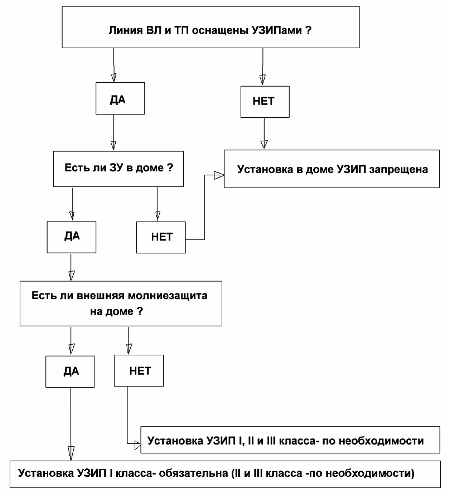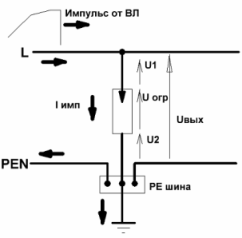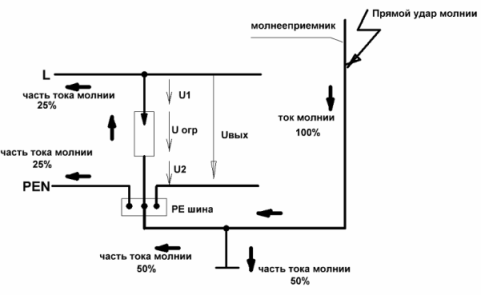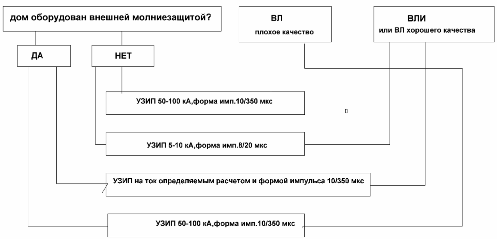Categories: Electrician at home, Safety precautions
Number of views: 55574
Comments on the article: 5
Electrosafe private residential building and cottage. Part 4. Surge Protection
Previous article:
Electrosafe private residential building and cottage. Part 3. Lightning protection
 Despite the theoretical possibility of the appearance of pulsed overvoltages with an amplitude of tens of kilovolts in the 0.4 kV power supply system, the REAL value of the amplitude is limited by the pulsed insulation strength of the electrical equipment.
Despite the theoretical possibility of the appearance of pulsed overvoltages with an amplitude of tens of kilovolts in the 0.4 kV power supply system, the REAL value of the amplitude is limited by the pulsed insulation strength of the electrical equipment.
The impulse insulation strength of electrical equipment with a nominal voltage of 230/400 volts is set by the standard and is taken equal to 6 kV. Based on this, the appearance of voltages higher than 6 kV in electrical circuits is unlikely (the appearance of amplitudes above 6 kV is possible according to Russian scientists only in 10% of cases).
Based on this, ALL electrical equipment up to 1000 volts was divided into 4 categories (for three-phase systems 230/400 volts):
- Category 4 - this equipment can withstand an impulse voltage of 6 kV (electricity meters, automatic machines, arresters, etc.),
- Category 3 - this equipment can withstand 4 kV surge voltage (sockets, switches, electric motors, switchboards, wiring, electric stoves, etc.),
- Category 2 - this equipment can withstand a surge voltage of 2.5 kV (this equipment is connected to outlets (household appliances, portable power tools, etc.),
- Category 1 - this equipment can withstand a surge voltage of not more than 1.5 kV (equipment containing semiconductor devices and / or microcircuits).
Now let's summarize some of the intermediate results:
1. Impulse overvoltage from the power supply network above 6 kV does not threaten us.
2. Since the electric meter, circuit breakers and surge arresters belong to 4 categories, there is no need to protect them from surge voltage.
3. All that is after paragraph 2 must be protected from them. overvoltage if necessary.
SPD.
Now that we understand the essence of the problem, it becomes clear how to deal with it. The main thing we need to do is to reduce the pulse voltage of 6 kV, if it appears, to a safe 1.5 kV. For these purposes serve SPD - surge protection device (limiter).
At the beginning of their development, SPDs were made separately for each category, for category 3 - class I limiters, for category 2 - class II limiters, for category I - class III limiters.
After the electric meter and the machine, which did not need protection, a class I limiter was installed, which cut off the voltage of 6 kV to 4 kV (1 stage of protection). Further along the power supply, a class II limiter was installed, which cut off the voltage supplied to it of 4 kV from the class I limiter - up to 2.5 kV (2 stage of protection). Then, again during the power supply, a class III limiter was installed, which cut off the voltage supplied to it from the class II limiter of -2.5 kV to 1.5 kV (3 stage of protection).
The observing reader will ask - why such difficulties — can it be immediately limited to them. The voltage is from 6 kV to the required 1.5 kV? I hasten to please him - with the development of technology this has become possible. Now Available universal SPDs combining in one case limiters of I, II and III classes, I and II classes, II and III classes. In this regard, there is no need to observe the minimum necessary distances (5-20 meters) between separate SPDs or instead install chokes between them that simulate such distances.
Next, a few words about our standards. Here is an excerpt from Technical Circular No. 30 for 2012
CIRCULARS OF THE ROSELECTROMONTAZH ASSOCIATION TECHNICAL CIRCULAR No. 30/2012 “ON EXECUTION OF LIGHTING PROTECTION AND GROUNDING OF VOLTAGE AND VOLTAGE UP TO 1 kV”
- Installation of subscriber SPDs is advisory in nature, and they can be installed both on the subscriber branch, and directly at the consumer.
- Installation of subscriber SPDs without installing SPDs on the line and on the transformer substation is not allowed.
- In networks with a voltage of 380/220 V (400/230 V), an SPD with a rated voltage of up to 450 V is used to protect lines, an SPD with a rated voltage of up to 280 V is used to protect subscriber single-phase branches.
- The presence of re-grounding and a potential equalization system for the consumer is mandatory.
That is, firstly, if we decided to protect our house with the help of an SPD, it is necessary to make sure that the SPDs are installed on overhead lines and transformer substations. Secondly, you must have a grounding device.
MY NOTE to Section 3 of the Circular. Due to the fact that voltage up to 380 volts is possible on a single-phase branch to the house in emergency situations, an SPD with a rated voltage above 380 volts is required (if the overhead line is made with separate wires).
In order not to get confused in all this, below I presented the decision-making algorithm for installing e-SPD in our house:
If all this takes place in your case (that is, all the necessary conditions are met), you can start work on protecting the house from overvoltage (already starting from other norms).
Next, let's see how an SPD of 1 cl. protection.
Fig. 1. Protection devices of class 1 SPD in case of overvoltage pulse from overhead line and from direct lightning strike
The figure above shows that the overvoltage pulse came through a phase wire from the overhead line to our house. If it is higher than 4 kV, then the arrester is triggered and one part of the current flows to the ground through our grounding device, and the other part flows to the PEN wire, which is re-grounded on the overhead line and connected to the transformer neutral earthed neutral point. In the figure below, it is seen that with a direct lightning strike into our air terminal, 50% of the lightning current flows through our grounding device, and the other half of the lightning current spreads evenly between the phase and neutral conductors. Based on this, and choose an SPD.
Lightning is rarely with a current strength of more than 100 kA, therefore, in calculations, the lightning current is taken for this value. So, 50 kA in our example went into our grounding device. The remaining 50 kA, when triggered by our SPD, will be distributed evenly between the L and PEN wires, that is, our SPD should be rated for a current of at least 25 kA.
About the air line ((VL).
It becomes clear that if the overhead line is in a deplorable state (the grounding slopes are rotten, cut off, etc.), then not finding the way to the ground, a lightning current will go straight into our house and do a lot of trouble. Thus, it is necessary to know your OHL well and if there is any doubt about its reliability, it is necessary to at least equip the pole from which your house is powered, that is, ground the wire on this pole, connect the hook (pin) on which the insulator is connected to this ground your phase wire, and if the support is reinforced concrete, then its reinforcement. Having done this, you will get, as it were, 1 line of defense already at the approach to the house. 2 line of defense - this is the installation of SPDs at the entrance to the house (1, 2 and 3 classes).
Note. Many now make a branch to the input wire SIP. If it is connected to a “poor quality” overhead line, then with PUM in the overhead line, a breakdown of the SIP insulation is possible, that is, it is necessary to do this branching with separate wires spaced from each other (or take additional protection measures).
On VLI (that is, VL made by self-supporting insulated wires - SIP), the situation will already be different. PUM (direct lightning strike) into an insulated phase wire is practically unrealistic and only a induced overvoltage pulse is possible in such a wire, caused by a close lightning discharge or from switching. To protect the insulation of VLI, networkers are already forced to carefully monitor the arresters, etc. so that the line is in good condition.
What conclusion can be drawn from what has been said? If the overhead line is in poor condition, it is necessary to “equip” the pillar from which our house is powered and to install a powerful arrester at the entrance to the house, designed to divert a lightning current of 50-100 kA (with a current shape of 10/350 μs).
If our house is powered by VLI, then the pole can be left alone and the arrester can be installed more simply (with a current shape of 8/20 μs and a current of 6-10 kA).
Now consider the same option, but the house is also equipped.
If the house is powered by VLI (or VL of which we are sure), then the SPD for the 1st stage of protection must be selected based on the distribution of the lightning current during PUM to the air terminal (as described above). If the house is powered by an overhead line, of which we are not sure, then it is necessary to proceed from the PUM to the phase conductor of the overhead line.
Fig. 2. Select SPD for the first stage of protection (click on the picture to enlarge).
In the next part, we will consider the SPD switching schemes for the TN-C-S and TT systems, how to select them, mount them and where to place everything, taking into account the specifics of a private house and its power supply from overhead lines, as well as the presence or absence of external lightning protection.
Continuation of the article: Electrosafe private house and cottage. Part 4 (ending). SPD selection examples
Mironov S.I.
See also at i.electricianexp.com
:




